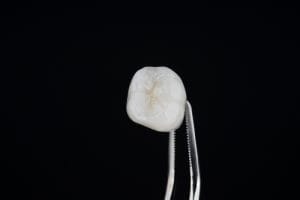
What are Dental Crowns?
Dental crowns, also known as caps, are prosthetic restorations that fit over a damaged or decayed tooth, covering the entire visible surface above the gumline. They are designed to resemble natural teeth, both in appearance and functionality. Crowns can be made from different materials, including porcelain, ceramic, metal alloys, or a combination of these.
Types of Dental Crowns:
There are several types of dental crowns available, each with its own set of benefits:
- Porcelain Crowns: These crowns are highly aesthetic, as they can be color-matched to the natural teeth. They are an excellent choice for restoring front teeth or those that are visible when smiling.
- Ceramic Crowns: Ceramic crowns are similar to porcelain crowns in appearance and durability. They are also highly aesthetic and suitable for restoring front teeth.
- Metal Crowns: These crowns are the most durable and offer the greatest strength. They are commonly used for molars, as they can withstand heavy chewing forces. However, they are not as aesthetically pleasing as porcelain or ceramic crowns.
- Porcelain-Fused-to-Metal (PFM) Crowns: These crowns have a metal substructure covered with a layer of porcelain, providing both strength and aesthetics.
- Zirconia Crowns: These crowns are made from a strong, tooth-colored material called zirconia. They are highly aesthetic and durable, making them an excellent choice for both front and back teeth.
- Composite Crowns: These crowns are made from a resin material that can be color-matched to the natural teeth. They are less durable than other types of crowns and are mainly used for temporary restorations.
Purposes of Dental Crowns:
Dental crowns serve several purposes, including:
- Protecting weak teeth from further damage or decay.
- Restoring broken or cracked teeth.
- Covering dental implants or anchoring dental bridges.
- Restoring the shape, size, and appearance of damaged or misshapen teeth.
- Strengthening teeth that have undergone root canal treatment.
The Procedure:
The procedure for getting a dental crown usually takes two to three visits to the dentist:
- Evaluation and Preparation: The dentist will evaluate your tooth and prepare it for the crown by removing any decay or damaged tissue. They will then shape the tooth to accommodate the crown.
- Impression: The dentist will take an impression of your prepared tooth, which will be used to fabricate the crown.
- Temporary Crown: A temporary crown may be placed on your tooth to protect it while the permanent crown is being made.
- Crown Placement: During your final visit, the dentist will remove the temporary crown and place the permanent crown on your tooth using a special adhesive.
Restore Your Smile and Confidence Today
Dental crowns are versatile restorations that can improve both the appearance and function of your teeth. Understanding the types, purposes, and procedures of dental crowns is essential for making informed decisions about your oral health. If you have a damaged or decayed tooth, consult us to see if a dental crown is the right solution for you. With proper care, dental crowns can last for many years, providing you with a confident and healthy smile. Contact Stiles Dental Care today.
